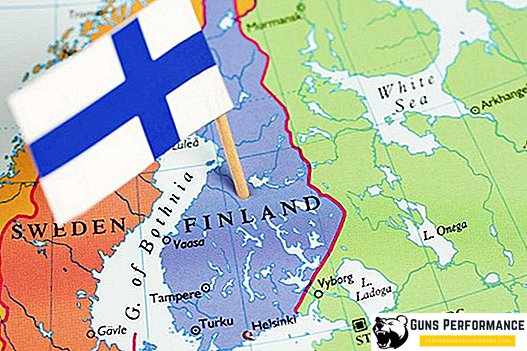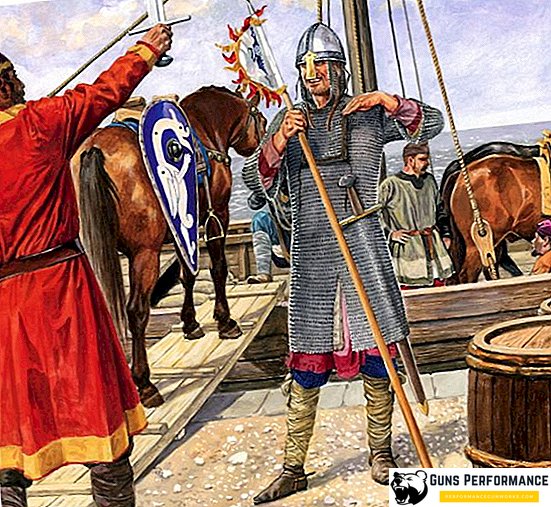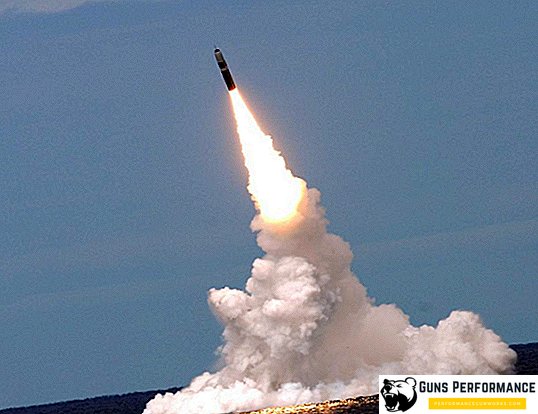In international law, there are not so many countries and states that have a relatively young political history. These powers include Finland. This small country, washed from the south and from the west by the cold waters of the Baltic Sea, nestled in the northwestern corner of the Scandinavian Peninsula. The modern history of the country began only 100 years ago. It was during this period that the country acquired all the necessary attributes of a sovereign state. From this point on, there is the presidency of Finland in the country, the Cabinet of Ministers regularly meets and Eduskunta works - the Finnish parliament.

Suomi under Swedish influence
The isolated geographical position could not ensure the present Finland a calm life and development. The country of Suomi (the old name) was on the sidelines of world politics for a long time, remaining a no-man’s land. In those early years there were neither strong sovereign rulers nor a clearly defined sovereign territory in this vast territory. The first shoots of statehood came to these lands only in the Middle Ages, when the country became a colony of the Swedish kingdom.

Beginning with the new millennium, when most of the countries of Europe were conquered by the Normans, who came from Denmark and Norway, Finland falls into the orbit of the interests of the Swedish Kunungs. Sweden, unlike its neighboring countries, Norway and Denmark, was more oriented towards the East. Swedish merchants and princes were interested in lands stretching in the eastern part of the Baltic Sea. Varyags skillfully took advantage of the situation that prevailed on these lands. Instead of aggression, the Swedes were able to subjugate the local tribes through bribing and through trade. Thanks to smart politics, the Swedes quickly spread their influence throughout the Baltic region, including the territory of present-day Finland.

Approximately the power of the Swedish kings and then the Swedish crown on the territory of modern Finland has spread since 1150. More accurate data on the colonization of Suomi point to the XIV century, when the borders of possessions of the Swedish kings and ancient Novgorod were clearly defined. The border of the Swedish possessions in Karelia passed along the Neva River. With the arrival of the Swedes in the territory of Suomi comes civilization. In southern Finland, the first settlements began to appear, which soon received the status of cities. The entire southern coast of Finland covers a network of fortified points, seaports and fortresses. Together with the Vikings, Christianity came to Suomi. The supreme authority on behalf of the Swedish crown in the country was exercised by the following persons:
- The first duke, who ruled in Finland, was Benedict, reigned 1284-1291;
- Waldemar, who ruled only six years from 1302 to 1318;
- The wife of Valdemar - Ingeborg, who occupied the ducal throne for 41 years from 1318 to 1353;
- Benedict, who occupied the throne in 1353-1357;
- Karl (1465-1467);
- Johan, who became the duke of Finland in 1556 and held this post until 1607;
- Adolf Gustov - Swedish king, who bore the title of Duke of Finland in the years 1607-1611.
During the reformation, Finland, walking in the wake of the Swedish kingdom, embraces Protestantism.

By the middle of the XVI century, Sweden reached the peak of its political power, becoming one of the largest and most powerful states in Europe. From that moment, Finland, which is in the status of a specific princedom, receives from the Swedish crown some kind of autonomy. From 1595, instead of Suomi, the Grand Duchy of Finland appears on the political map of Europe. The capital city of Abo becomes the capital of the new state formation. Initially, the right to reign in Finland received noble feudal lords.

The status of the Duke of Finland with the accession of Gustav Adolf becomes the prerogative of the royal personage. Since the middle of the XVI century, almost all the rulers who occupied the ducal throne in Abo, become kings of Sweden. Subsequently, the title of duke (prince) of Finland was given to the crowned person along with the royal title. All subsequent monarchs of Sweden were called the King of Sweden and the Grand Duke of Finland. The loud name of the state did not give Finland any privileges. The country continued to be the patrimony of the Swedish crown. Even formal institutions of state power were absent in the country. The force of law in the territory of the Principality of Finland was carried by royal decrees. All orders of the duke were made on behalf of the king and were binding.

Finland within the Russian Empire
A new era in the history of Finland begins in 1809, when the Grand Duchy of Finland became part of the Russian Empire. This fact was initiated by the peace of Tilsit, concluded between Emperor Napoleon and the Russian Tsar Alexander I. Sweden, as an ally of Great Britain, was forced to go to war with Russia, but lost it. No matter how hard the Swedish king Gustav IV tried, under the terms of the peace treaty, Russia took possession of the entire territory of the Finnish principality. In the spring of 1809, Emperor Alexander I, by his decree, issued a manifesto which referred to the state system of Finland within the Russian Empire.

In accordance with the text of the manifesto, the country received administrative borders within its territory. Preserved in Finland Finnish laws concerning the system of government. For the first time in the history of the Finnish state a class meeting was assembled, which became the prototype of the Finnish parliament. Subsequently, the Grand Duchy of Finland became a detached house in the administrative system of the Russian Empire. In Suomi, the political movement is actively developing and the industrial revolution is proceeding at a rapid pace. Finland, together with the Kingdom of Poland, becomes the outpost of Russia in Western Europe. Under Emperor Alexander II, Finnish became the state language. The country gets more autonomy. However, the idyll in relation to the Empire with its autonomy ended at the end of the XIX century, when Finland was faced with the royal policy of forced Russification. The start to the independence of Finland was given by the February revolution. From that moment on, the country embarked on the path of acquiring its own statehood.
New history of the country: the first president of Finland
After learning about the abdication of Nicholas II in Suomi, irreversible political processes began in the country. All social, political and administrative integration activities initiated in 1899 were canceled. The country received a new governor-general. After a long political pause, the Finnish Sejm was again convened, which made an independent decision on the country's internal independence. An attempt by the Provisional Government to prevent the rapidly collapsing bilateral Russian-Finnish relations with the help of an armed force failed. Russian troops in Finland withdrew from submission, the gendarme corps and the police were disbanded.

Despite the fact that the Seimas of the country was formally dissolved, the question of independence was in the air, the course taken by the country was becoming more and more clear. During the summer of 1917, Finland was torn by chaos, anarchy and unrest. The October Revolution of 1917, which put an end to the rule of the Provisional Government in Russia, opened up new opportunities for the Finnish political class. A month after the fateful events in Petrograd, the Finnish Senate on December 4, 1917 adopted the Declaration of Independence of Finland. After 2 days, the Finnish Parliament approved the decision of the Senate, at the same time proclaiming Finland a Republic.

The government of the Bolsheviks, led by V.I. Lenin, considered the issue of recognizing the independence of the Finns, but attracted official recognition. The civil war that flared up towards the end of the year gave the Bolsheviks hope that the Grand Duchy of Finland would remain part of Soviet Russia. These aspirations were not destined to be fulfilled. With the support of the troops of Kaiser Germany, the troops loyal to the Finnish government were able to crush the troops of the Finnish Red Guard. With the support of the Germans in the first half of 1918, bourgeois-democratic forces finally seized power in the country. In May of the same year, a meeting of the Finnish parliament was held, at which they spoke about the introduction of a monarchical form of government in the country. The result of a long parliamentary debate was the proclamation of the Kingdom of Finland.

The royal throne was to be given to Frederick Karl, the husband of the sister of the German emperor Wilhelm II. These plans also came true. The defeat of Germany in the First World War led to the fact that the political weight of the Germans in Finland was significantly weakened. The new Finnish king remained in Germany, even formally not having entered its rights. During the short existence of the Kingdom of Finland in the absence of the king, all power in the country was in the hands of the Regency Council. After the king abdicated the throne on December 12, 1918, Karl Gustav Emil Mannerheim was elected the new head of the Regency Council. From this moment on, the history of the country will be closely connected with this ambiguous personality.
In the summer of 1919, the new composition of the Finnish parliament again returned Finland to the fold of democratic states, restoring the republican form of government in the country. The status of the President of Finland was approved by the Constitutional Act, which approved Mannerheim as regent. The result of these transformations was the July 25, 1919 presidential election. The election of a new head of state was held within the walls of the Finnish parliament. Following the results of the secret ballot, Kaarlo Juho Stolberg, the representative of the national progressive party, became the first elected president of the country. The new president of the country was in power from July 1919 to March 1925.

Mannerheim, who also claimed the post, lost. This was due to the lack of confidence on the part of the bourgeois majority in Mannerheim as a political figure. According to reports, Carl Gustav Mannerheim led secret negotiations with the leaders of the Russian white movement, considering the possibility of joint efforts to defeat the Bolsheviks. After his fiasco in the July presidential election, Mannerheim went to the UK.
Beginning in 1925, a new procedure for electing the head of state was introduced in the country. The president was not to be elected by the deputies of the Finnish parliament, but by an electoral college representing the interests of the entire population of Finland. This procedure, with some exceptions, continued to operate until 1982, when a mixed electoral system was introduced in the country: nationwide voting + the result of voting by an electoral college.
Duties and powers of the president
The country of Suomi, having become a parliamentary-presidential republic in the 1920s, could set an example for other states on how to maintain the political balance of all branches of government. In accordance with the 1919 Constitutional Act, the Finnish Constitution established a clear delineation of powers and the status of the president.
The President of Finland has the legal right to initiate legislation, sending his draft laws to the Finnish Parliament. At the request of parliamentarians, a presidential bill can be sent for approval, for analysis and discussion to the Supreme or Supreme Court of Appeal of Finland.

Parliament, in turn, passing laws, sends them for signature to the president of the country. The head of state also has the right to appeal to the Supreme Court for clarification on the essence of the law. Laws that are not signed by the president are sent to parliament again, where they need to be voted by an absolute majority. Otherwise, the law will be considered as not adopted.
Decrees, decisions and orders of the president have legislative force, but in most cases require the approval of the Government of the Republic. The inauguration of the President takes place within the walls of the Finnish Parliament in a solemn atmosphere. Since taking office, the head of state is assigned a salary, the amount of which is fixed and is determined by the relevant laws. The term of office of the president of the country is 6 years. In the absence of political obstacles, the incumbent president can run for a second term. The Basic Law did not provide for restrictions on the number of presidential terms. The person who won as a result of the election could have been for several consecutive terms.
The responsibilities of the Finnish president include the convening of a Sejm in emergency situations, the dissolution of the Finnish parliament, the announcement of new parliamentary elections. It is in the competence of the President of Finland to grant pardon, to decide on the granting or deprivation of citizenship, to exercise in practice the right of dispensation (exemption from execution in certain cases of the laws of the country).
The president is in charge of state supervision over the entire system of state power in the country. The head of state plays the role of arbiter between all branches of state power in the country.

The head of state is the Supreme Commander of the country's armed forces.
The responsibilities of the country's president in the international arena are as follows:
- appoint ambassadors and consuls to foreign countries;
- accept credentials of foreign ambassadors;
- the conclusion of treaties, unions with foreign countries with the approval of the Finnish Parliament;
- The president is authorized to declare mobilization in the country, to impose martial law in the country, to declare war.
Presidents of the Republic of Finland
With the establishment of a parliamentary-presidential republic in the history of the state there were 12 presidents. Each of them was in power for some time and ruled the country in the most different periods of its history. Representatives of four political forces became the head of state: the National Progressive Party, the Finnish Center, the National Coalition, and the Social Democratic Party. Only one of them, Carl Gustav Mannerheim, the sixth President of the Republic of Finland was non-partisan and put forward independently.

Following the country's first president, Kaarlo Juho Stolberg, the following persons held the presidency:
- Lauri Christian Relander, reigned 1925-1931;
- Per Evind Swinhoodwood held the presidency in 1931-1937;
- Kyosti Kallio was President of the Republic from March 1937 to December 19, 1940, (the period of the Soviet-Finnish War of 1939-40);
- Risto Ryti was in office from December 19, 1940 to August 1, 1944. Resigned after Finland’s withdrawal from the war;
- Karl Gustav Emil Mannerheim, who became president in December 1944 and held this post until March 4, 1946. Signed a truce with the Soviet Union and brought the country out of the war;
- Juho Kusti Paasikivi, reign 1946-1956;
- Urho Kaleva Kekkonen became head of state in March 1956 and held this post the longest, until 1982;
- Mauno Henrik Koivisto assumed the presidency on January 27, 1982, and remained in office for 4,417 days, until March 1994;
- Martti Ahtisaari became president in March 1994 and remained in that post until March 2000;
- Tarja Halonen was president of the country for 12 years, from March 2000 to March 2012;
- Sauli Niinistö is the current president. The term of office expires in 2024.


Innovations in the procedure for electing the President of the Republic of Finland and tenure are determined in the new Constitution of Finland adopted in March 2000. The new Basic Law approved the procedure for electing the head of state based on the results of a direct popular vote. The term of office of each president is 6 years. From this point on, every head of state cannot hold a high position for more than two terms in a row.

The official residence of the head of state is the Presidential Palace, located in the capital Helsinki. In parallel with it, the residence of the President of Mäntuniemi, built in 1993, is used as the residence of the president. Here lived the presidents of Finland Mauno Koivisto, Martti Ahtisaari and Tarja Halonen. Today, the apartment is occupied by the current president of the country, Sauli Niinistö.
Of all the listed presidents of the country, only five left a prominent place in history. Per Evind Swinhoodwood is considered the forefather of the institution of parliamentarism. In the years of his reign, all parties of a communist kind disappeared from the political arena. Svinhuvud took an active anti-Soviet position and advocated a union of Finland with the fascist regimes of Italy and Germany. Risto Ryti entered the history of the country as president, plunging the country into the depths of the Second World War. Ryti became the only head of state who was subsequently convicted of war crimes.

Карл Густав Маннергейм является исторической личностью в истории Финляндии. Благодаря ему Финляндия из провинциальной страны превратилась в полноправный субъект международного права. При Маннергейме - президенте государственного совета обороны - возрождается финская армия. В 1933 году за политические и военные заслуги Маннергейму присваивается высшее воинское звание фельдмаршал Финляндии. Благодаря усилиям президента Маннергейма Финская Республика не стала в 1944 году зоной оккупации советскими войсками, сохранив свою независимость.

Два других президента Урхо Калева Кекконен и Мауно Койвисто сделали из Финляндии образцовую картинку. Благодаря усилиям обоих, страна прочно заняла место на международной арене, войдя в Европейский Союз в качестве полноценного члена, сумела сохранить свой нейтральный статус.












